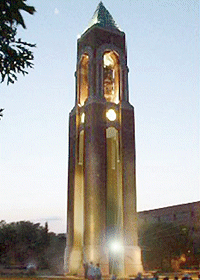Campus Briefs
:: NEWS
NO PLACE FOR MYSPACE. After determining that about 40 percent of the school’s Internet traffic was
to and from MySpace.com, administrators at Del Mar College (TX) have prohibited access to the popular social networking
site via computers connected to the campus network, hoping that the saved bandwidth will be used for instructional
purposes.
NAME THAT TUNE. UC-Berkeley (CA) has joined a small but growing group of schools distributing video
and audio recordings of course lectures and other content through Apple’s iTunes Music Store. “Berkeley
on iTunes U” is open not only to Berkeley students and staff, but also to the general public, at itunes.berkeley.edu.
SUPERCOMPUTING SERVICES. Indiana University is acquiring what university spokespeople think will be
the fastest university-owned supercomputer in the US (or 3rd in the world for universities), capable of performing more than
20.4 trillion numerical operations per second. The new e1350 cluster, based on IBM’s JS21 blade technology,
will be paired with more than 1 petabyte (PB) of high-speed disk storage, plus tape amounting to 2PB. IU will spread
the supercomputing power among various disciplines, leveraging a services model for advanced research computing.
NO ASSUMPTIONS HERE. This spring, Missouri State University was among the 38-plus institutions in the first administration
of the new Core version of the ETS Information and Communication Technology (ICT) Literacy
Assessment. Sue McCrory, coordinator of Missouri State’s Computers for Learning course, explains why her institution gave
the test to 1,500 students: “There is an assumption that because students have grown up with computers, they are ICT pro-
ficient. Yes, they can IM and buy things online, but many of them have never used a spreadsheet or don’t know whether the
information they are finding on the Internet is from an authoritative source. This assessment can help us validate areas in
which our ICT curriculum is successful, and point out some areas where we may need to make changes.”

TECH AS ART: Ball State’s Shafer
Tower: a sensory network experience?
USING FUSION. Michigan Technological University has implemented Oracle Portal, a component of Oracle
Fusion Middleware, to offer an admissions and recruitment portal. Prospective students access the
portal for general information and university content, applications, key deadlines, billing, and even roommate
selection. Admissions personnel and recruiting staff can use the portal for secure access to reports,
and to offer individualized recruitment services.
ADVANCEMENT OF TEXTING. With the
premise that 75 percent of all college students use text messaging, the Technology Advancement Center
at East Carolina University (NC) is working on a project that will allow instructors to send out
course updates to their students’ cell phones, while the administration will be able to use the same system
for weather and crime alerts.
ART IMITATES NETWORK. Artists and IT managers at Ball
State University (IN) collaborated this spring on an interactive digital sculpture project depicting the
school’s wireless network infrastructure in a multisensory experience incorporating projection screens,
cameras, computers, speakers, lights, and even the carillon bells in the campus’s Shafer Tower. The
sights and sounds reacted to changes in network activity and traffic location in real time. The sculpture
will be recomposed and displayed permanently on a series of wall-mounted plasma screens; plans are
to overlay real-time and historical data that illustrate the full spectrum of campus wireless traffic.

